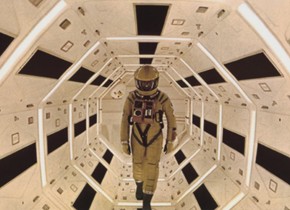Science : Fiction
A History of the Future
February 9 to March 10, 2011
Science fiction has no easy task. A bastard child of the marriage between science, story-telling and social philosophy, it is supposed to depict the most controversial of all human notions (parallel worlds, the future) and to give a new and credible spin to two concepts which are hardly understood by anyone in the present (time, space). Accordingly, its borders are hard to define: Science fiction often extends into fantasy, borrows themes from the horror genre, or takes the shape of realistic drama. It consistently transforms itself, adapting to new eras and the changing zeitgeist – both in terms of technological change and in its thematic and aesthetic preoccupations.
Assembling fifty major works from the period between 1946 to 2008, the Film Museum retrospective traces the development of modern science fiction cinema – with its international diversity, subversive variations and visionary proposals. The examples span from famous, seminal works such as 2001: A Space Odyssey and Solaris to neglected classics like Karel Zeman’s definitive Jules Verne adaptation Vynález zkáky; from philosophical ‘B’ pictures (The Incredible Shrinking Man) to blockbusters (the vicious satire of Starship Troopers); from revitalizations of cinema in the spirit of the 1960s (Seconds, Alphaville) to unusual literary adaptations such as Aleksandr Sokurov’s Days of the Eclipse, based on a novel by the brothers Strugatsky. The show also features avant-garde shorts, essay films and mockumentaries, as well as several recent sci-fi productions which deal with current issues in a much more innovative manner than their Hollywood counterparts (e.g., the challenges posed by ‘virtual reality’ in Demonlover by Olivier Assayas).
The series begins with the immediate Post-War years, when the term “science fiction” first became popular and new distinctions needed to be made in the broad fields of fantasy and utopian fiction. The period marked a decisive reorientation for the genre and precipitated a new “Golden Age” of science fiction. Under the influence of world war and the atomic bomb, as well as the start of the arms and space races (the Cold War would provide plenty of material over the following decades), popular culture began to reconsider technological development and its ethical implications. Two of the earliest examples – Krakatit (1947, from a novel by Karel Čapek) and The Man in the White Suit (1951) – deal with the responsibility of the scientist in the face of a potent invention which is promoted by the forces of power. This question of progress and its effect on man and morality runs through the entire show – all the way up to the nuclear-fusion-kaleidoscope of Miike Takashi’s God’s Puzzle (2008).
Meanwhile, Destination Moon (1950, co-written by Robert A. Heinlein) created a blueprint for the space opera: the model for many subsequent fantasies of U.S. conquest as well as for the pursuit of scientific and technical authenticity, which would reach a new benchmark in 2001: A Space Odyssey. A half-century later, Starship Troopers, again adapted from Heinlein, turned the reactionary thrust of the space opera completely on its head. Similar threads can be drawn through other themes in the series – for example, the alien invasion motif, either seen as a “pacifist” offering in The Day the Earth Stood Still (1951) and John Carpenter’s Starman (1984) or as an overt threat in Invasion of the Body Snatchers (1956) and Carpenter’s anti-Reagan allegory, They Live (1988). The latter work also connects with a series of disturbing images of a “regulated” society – whether as a no-man’s-land of glass architecture in Alphaville, a book-burning nightmare in Fahrenheit 451 (from a Ray Bradbury novel), eco-disaster in David Cronenberg’s early Crimes of the Future, as a neo-noir hybrid in Blade Runner or a bad drug trip in A Scanner Darkly, both adapted from novels by Philip K. Dick.
As strong as literary influences have been upon science fiction, trends in public discourse and the visual arts have left an even greater mark on the genre: 1960s nuclear fear – done in cooly modernist fashion (The Damned) or as ‘cinema-vérité’ (The War Game); the craze for pop and psychedelia, between Italy (The Tenth Victim) and the U.S. (Fantastic Voyage); the disillusioned and critical tone of 1970s popular culture (Silent Running, The Terminal Man); the appropriation of “cyberpunk” (The Terminator) or comic book iconography (RoboCop) in the eighties – and finally the genre’s re-orientation towards “alternative” border zones and “new regions” such as Asia, which are fed by other, non-mainstream traditions and impulses.
As demonstrated by the exemplary double feature of Chris Marker’s brilliant miniature of time travel, La Jetée, and Terry Gilliam’s daring big-budget remake, Twelve Monkeys, the changing fashions, designs and themes only serve as mirror shapes and allegories of the actual science fiction narrative. Whether through fantastic images of the future, outer space, or alternate identities – man is ultimately in a search for knowledge of the present, the ‘inner space’ of society, and above all: himself.
The retrospective will be accompanied by several presentations and guest appearances: Natalja Bondarčuk, the lead actress of “Solaris”, and the filmmakers Deimantas Narkevicius and Michael Palm will discuss their respective works. Hans Langsteiner, Barbara Wurm, Olaf Möller and Christoph Huber (co-curator of the show) will present introductions and lectures.
Related materials


